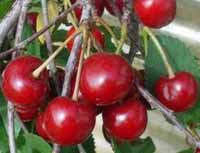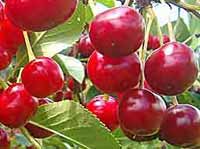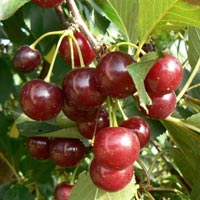SOUR CHERRY SEEDLINGS
or
SOUR CHERRY FRUIT TREE PLANT
SOUR CHERRY seedlings generally grow as a bushy tree and grow best on hillsides and slopes facing south, southeast or east.
Sour cherry in winter, when it is still, can withstand temperatures of -35 degrees. But when it starts vegetation, it becomes sensitive to cold. The sour cherry trunk can “get cold” because of the large temperature fluctuations characterized by cracking of the bark. Sour cherry is most sensitive 3 to 4 weeks before and during flowering when it will suffer damage at temperatures below -2.2 °C. Otherwise, sour cherry is quite resistant to high temperatures, and even temperatures that are higher than 30 degrees won't bother it.
Sour cherries are most suitable for permeable, warm and deep soils (sandy, loamy and loamy-clayey). Drainage is obligatory if the soil is heavier, because this type of soil does not suit sour cherries.
Sour cherry (Lat. Prunus cerasus) is a species of woody angiosperms, as well as the name for its fruit (used in human nutrition as fruit). It belongs to the family Rosaceae, genus Prunus (as well as almond, peach, plum, apricot), and sub-genus Cerasus. The natural range of distribution includes most of Europe and southwest Asia.
Sour cherry is grown on modern plantations and its fruit are used to make: juices, jams, stewed drinks, sour cherry preserves, or is stored frozen to make various treats (creams, syrups, ice cream...). In addition, sour cherry is used for brandy (sour cherry brandy).
In southeastern Serbia, there is a well-known area in the Nišava district surrounding the village Oblačina in Merošina municipality, where a special type of sour cherry is cultivated, the so-called Oblačina cherry.
Origin, significance and distribution
Sour cherry is thought to be native to Anatolia and that it was carried over to European countries through Greece and ancient Rome before the beginning of our era. Man used the fruit of wild cherry for nourishment, while it had been growing spontaneously. There is no accurate data regarding the period when sour cherries started being grown in our country.
Sour cherry has the ability to adapt well in almost all environmental conditions, and therefore has a wide range of distribution. In addition, it is characterized by early fruitfulness (2-3 years) as well as regular and abundant fruitfulness.
It is less attacked by diseases and pests than other fruit species. Fruit are used fresh, frozen and processed into juice, jelly, syrup, marmalade, preserves.
Russia is the largest producer of sour cherries, where it takes second place in the fruit growing structure, right after the apple. In the USA, France, Germany, England and some other countries in Europe, sour cherry cultivation is of great importance. There is a great interest in its fruit all over the world. It is a quality raw material in the fruit processing industry.
Sour cherry fruit is an excellent raw material for various forms of processing, and above all for the production of juices, jelly, preserves, etc. Very significant quantities of its fruit are frozen and exported. The fruit of some varieties, such as kereška, can also be used as table fruit.
Blooming, pollination and fertilization
In our ecological conditions, sour cherry buds are formed from the second half of June to mid-July in the year preceding blooming.
Sour cherry begins to bloom after peach and sweet cherry, which in our climate usually occurs in mid-April. In terms of pollination, i.e. fertilization, all sour cherry varieties can be: self-fertilizing (for example, Rexele and Oblačina cherry), partially self-fertilizing (Čačak ruby) and self-futile (kereška).
Amarelles are characterized by the fact that they are mostly self-futile. Most sour cherry varieties are self-futile, and their growing requires pollinator varieties. Only self-fertilizing varieties can be grown in one-sided, clean plantings.
Sour cherry blossom is hermaphroditic (complete). Sour cherry is an entomophilic plant, and the honey bee is its most important insect pollinator. In cross-fertilization, self-fertilizing varieties are more fruitful. The fruit ripens 35 to 60 days after blooming.
Environmental conditions for sour cherry cultivation
Thanks to the long and stable hibernation, it can withstand winter frosts up to -40 °C. Its blossoms are more resistant to late spring frosts than the sweet cherry blossoms. It thrives well in arid regions with an annual rainfall of about 400 mm (if properly distributed). It grows and blooms at altitudes above 700 m. It thrives in all sites except in closed valleys where there is no ventilation. Mountainous sites suit it best, with slight slopes and southeast and east exposure and moderate humidity.
It grows well on almost any soil that is not very limey, salty, very acidic and very alkaline. Still, it thrives best on sandy loam, alluvial and carbonate chernozem.
Seedlings of SOUR CHERRY – ŠUMADIJA CHERRY:
 Description:
Description:
These seedlings are of domestic origin. It has the largest fruit of all sour cherries. The fruit is hearty, the epicarp is red to dark red, the fleshy part is semi-firm, juicy delicious, juice colored.
Ripening time: First half of August
Rootstock: Wild Cherry, Mahaleb Cherry
Seedlings of SOUR CHERRY – OBLAČINA CHERRY:
 Description:
Description:
Its origin is unknown. Poor to medium lush. Tolerates different terrains well. It is self-fertilizing, of medium early blossoming, becomes fruitful in the third year after planting, very fruitful. It is the most widespread variety in Serbia.
Ripening time: End of June
Rootstock: Offshoot of Oblačina cherry
Seedlings of SOUR CHERRY - KELLERIS:
 Description:
Description:
The Kelleris seedlings are originally from Denmark.
The fruit is medium in size (4-5 g). The fleshy part is sour and of pleasant aroma.
The tree is poorly lush, erect crowns with many small bent branches. It blooms late. It is self-fertilizing and of excellent fruitfulness.
It is suitable for table consumption, freezing and various types of processing.
Ripening time: Beginning of July
Seedlings of SOUR CHERRY - ERDI BÖTERMÖ:
 Description:
Description:
The fruit of Erdi Bötermö is 5-7 grams, dark red. Medium lush and of good fruitfulness. It is self-fertilizing.
Ripening time: Beginning of July
Rootstock:
